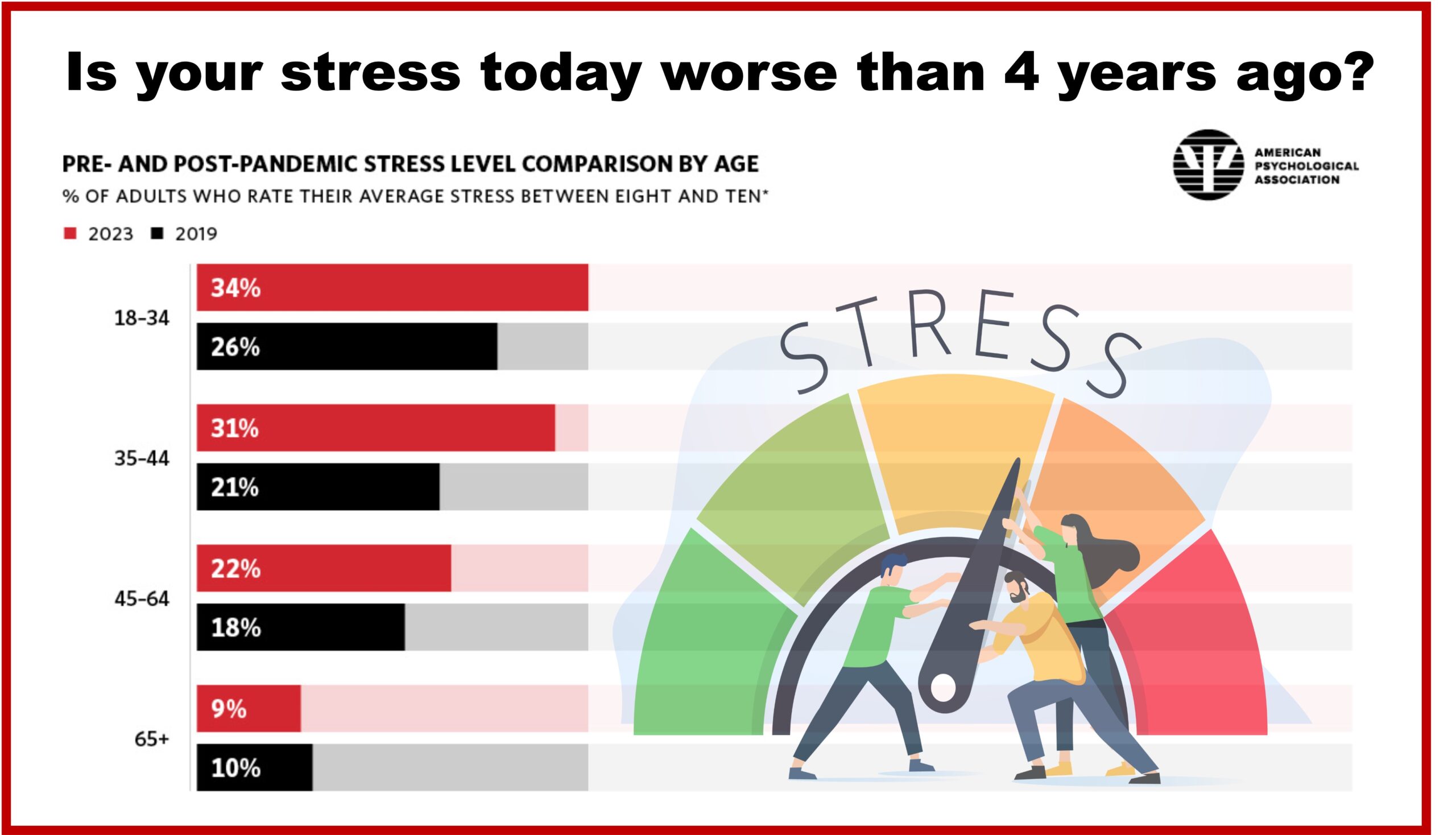Weekly Data
WHAT THE DATA SAY: 35- to 44-year-olds hit stress boiling point and 10-point increase in health issues
By: Ray Day
CONTACT:
We wanted to share our latest consumer and business insights, based on research from Stagwell. Among the highlights of our weekly consumer sentiment tracking:

ECONOMIC WORRIES HIT MIDDLE CLASS HARD
Middle-class Americans are more worried about the state of the economy than a year ago, according to our Harris Poll research with Bloomberg.
- 61% of middle-class Americans say their personal financial situation is worse or unchanged from a year ago.
- 12% say they are in a “much better” circumstance.
- 63% report that stagnant wages hurt their finances, and 42% say costs are rising faster than their wages.
- Three quarters say they are paying more for goods and services, and two thirds say higher prices for household essentials are hurting them.
- 57% report higher borrowing costs are hurting household finances.
POST-COVID STRESS CAUSING HEALTH ISSUES, ESPECIALLY FOR 35- TO 44-YEAR-OLDS
The long-term stress caused by COVID continues to have a significant impact on well-being – especially for 35- to 44-year-olds suffering with the most significant increase in chronic health conditions since the pandemic – according to the Stress in America survey by the Harris Poll for the American Psychological Association.
- The APA points out that ongoing stress wears on the immune system and increases the risk of digestive issues, heart disease, weight gain and stroke.
- Those ages 35 to 44 report the most significant increase in chronic health conditions after COVID: 58% in 2023 compared with 48% in 2019.
- Adults ages 35 to 44 also experienced the highest increase in mental health diagnoses: 45% in 2023 compared with 31% in 2019.
- People in this age group say money (77% today versus 65% in 2019) and the economy (74% today versus 51% in 2019) are the two factors causing the most significant stress.
- The majority of adults downplay stress, with 67% saying their problems aren’t “bad enough” to be concerned.
- When asked why they don’t seek treatment, top reasons are: belief that therapy doesn’t work (40%); lack of time (39%); and lack of insurance (37%).
- 24% of adults rate their average stress between 8 and 10 on a scale of 1 to 10 (where 1 means little to no stress and 10 means a great deal of stress). This is up from 19% in 2019.
- This increase is mirrored across all age groups except those age 65+: 34% of ages 18 to 34 reported stress between 8 and 10 (up 8 points from 2019); 31% for ages 35 to 44 (up 10 points); 22% for ages 45 to 64 (up 4 percentage points); and 9% for those 65+ (down 1 point).
- Parents of children under the age of 18 who rank average stress between 8 and 10 also saw a significant increase – 33% today versus 24% in 2019.
AI A TURN-OFF TO BOOMERS SEEKING JOBS
Hiring managers are alienating older job applicants with automated HR tools – just as record numbers of retiring Boomers are applying, according to our Harris Poll survey with Indeed.
- 87% of employers say they view automated hiring positively.
- Yet older workers bristle at AI: 71% of those 18 to 35 say using automation makes them feel valued versus only 43% of those 36 and older.
- 55% of younger job seekers say automated hiring processes make a company appear more innovative, yet only 33% of older applicants say the same.
- 49% of job seekers also believe AI tools used in job recruiting are more biased than their human counterparts.
AI VIEWED POSITIVELY FOR HEALTH CARE
While older Americans question AI hiring, many want more digital methods managing their health, according to our Harris Poll survey with Elevance Health.
- 89% of adults 65 and older who have used virtual primary care for a healthcare need have been satisfied with the experience.
- 78% of those 65+ agree that virtual primary care can be a great way to increase access to healthcare for people who are unable to visit a provider in person.
- 40% of those 65+ are likely to use virtual primary care in addition to the care they receive from their current health provider in the next five years.
ICYMI
In case you missed it, check out some of the thought-leadership and happenings around Stagwell making news:
- The Workplace is Becoming More Political as Gen Z Comes of Age
- Over a third of NYC homes for sale get taken off market without finding a buyer
- Views from Stagwell’s Crispin Porter + Bogusky and Code and Theory: As more brands use generative AI to create social content, agencies are changing how they measure its success
- Code and Theory’s Head of Design Transformation On How Businesses Can Get Unstuck in 2024
Related
Articles
In the News, Press Releases, Talent & Awards
Mar 12, 2025
GALE Wins Ad Age Business Transformation Agency of the Year and Adweek U.S. Media Agency of the Year

In the News, Press Releases, Talent & Awards
Mar 10, 2025
Four Stagwell (STGW) Agencies – 72andSunny, Anomaly, Code and Theory and GALE – Awarded 2025 Ad Age Agency A-List Recognition for Business and Creative Transformation

In the News, Press Releases
Mar 07, 2025
Left Field Labs Celebrates 17 Years of Building What’s Next Amid Expanding Global Client Roster





